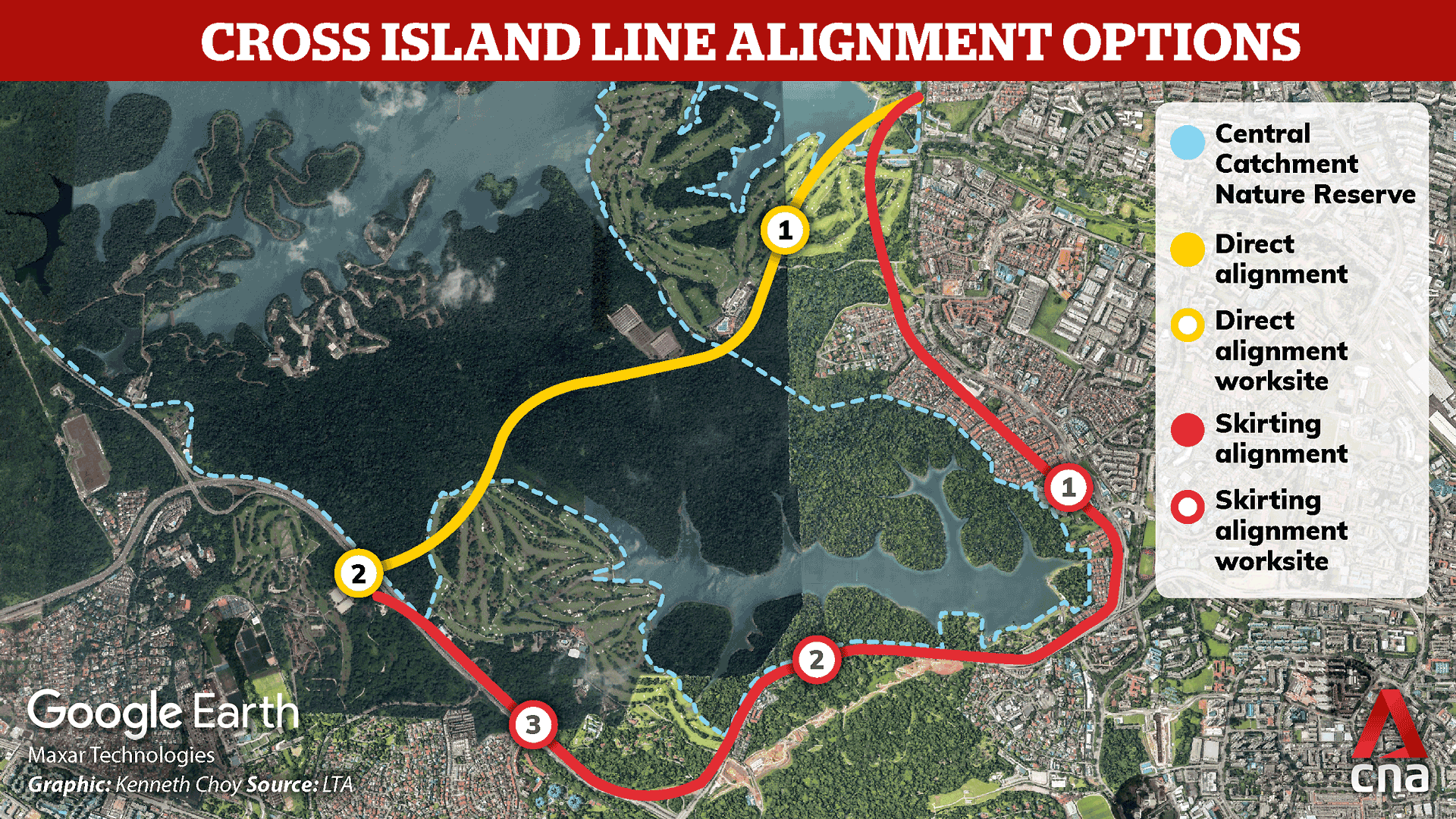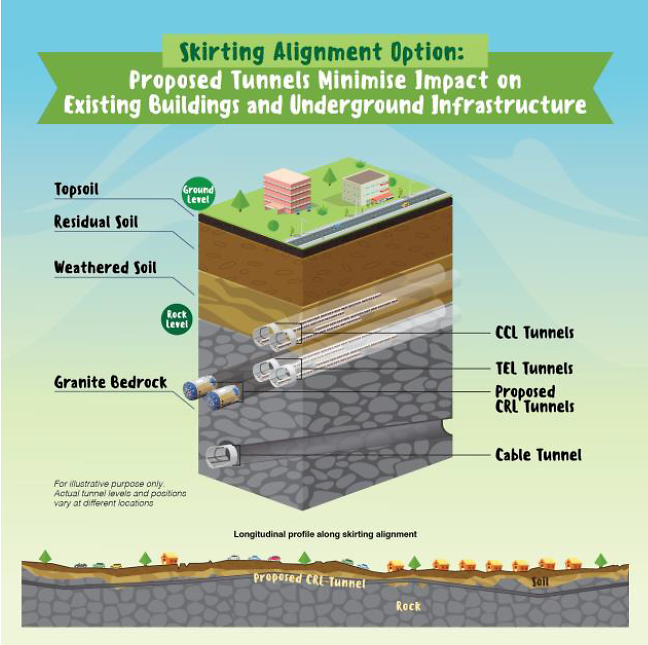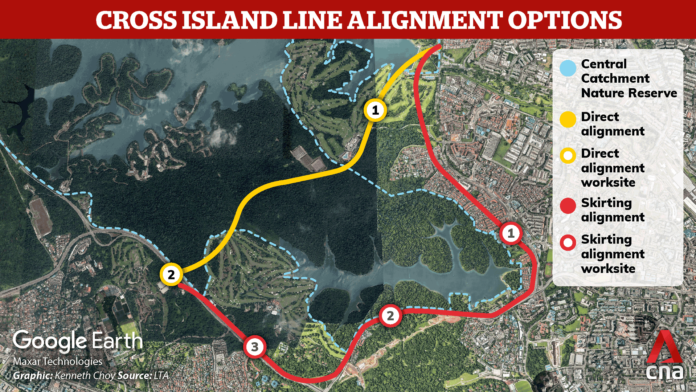SINGAPORE: The environmental impact of both proposed routes for the Cross Island Line (CRL) near the Central Catchment Nature Reserve (CCNR) can be “adequately managed” with “comprehensive” mitigation and monitoring plans, a study commissioned by the Land Transport Authority (LTA) has found.
The direct route involves building a 2km tunnel about 70m deep under the CCNR, worrying green groups who want Singapore’s wildlife and nature preserved.
READ: Wildlife seen in Cross Island Line site investigations
The other route is a 9km stretch going around the reserve and under homes and businesses, increasing end-to-end travel time by about four minutes. This option adds an estimated S$2 billion in costs, and the Government said it may also need to acquire land.
Both routes will not involve surface works in the nature reserve. The direct route will have two worksites outside the CCNR, while the skirting route will have three worksites outside the CCNR, one of which will be located next to a residential estate on Upper Thomson Road. The worksites will be converted to permanent facility buildings for the CRL.

Proposed alignment options for Singapore’s Cross Island Line.
LTA said in a statement on Monday (Sep 2) that the expected environmental impact of both routes is “largely confined” to parts of the tunnel and construction worksites outside the CCNR, adding that this can be managed by “robust” mitigation measures, citing the study.
“This can be achieved through locating the worksites as far as possible from the CCNR and the implementation of a comprehensive Environmental Monitoring and Management Plan (EMMP) to protect flora and fauna,” it stated.
“This EMMP will also help to mitigate any disamenities to nearby residents.”
An independent panel of international advisers, comprising industry experts in tunnelling and underground construction, has also reviewed engineering schemes for both routes and concluded that tunnelling along both options is safe with control measures in place.
These findings are part of the second phase of the Environmental Impact Assessment (EIA) for the underground stretch of the CRL near the CCNR. The first phase, completed in February 2016, had evaluated the environmental impact of site investigation works in the CCNR.
However, LTA has not made a decision on the final route of the CRL.
“In addition to the EIA findings, the Government will consider other factors, such as transport connectivity, travel times, costs and impact on home owners and commuters, when deciding on the final route of the CRL,” it added.
LTA has not set a timeline on when it will make a decision on the final route. The public can give feedback on the report for one month, before LTA starts advanced engineering studies on one or both routes next year, a process that can take two years.
“LTA will mitigate the environmental impact of the chosen alignment, and put in place a robust EMMP as laid out in the EIA report,” the agency said. “The EMMP will also be further assessed and strengthened as the project progresses.
The CRL, a roughly 50km fully underground MRT line with about 30 stations spanning Jurong to Changi, is expected to open in 2030. Commuters are expected to make at least 600,000 trips daily on the CRL, more than the existing North-East Line.
READ: First phase of Cross Island Line to open by 2029 with 12 stations
READ: Cross Island Line: A closer look at the first 12 stations
It will also connect existing radial MRT lines with almost half of its stations being interchange stations, and is part of a plan to almost double Singapore’s rail network by 2030 and put eight out of 10 households within a 10-minute walk of a train station.
IMPACT OF DIRECT ALIGNMENT
For the direct route, the impact to people during the construction phase includes an impact on nearby water resources and noise pollution to Windsor Park residents due to construction activities, the study found.
The study noted that this impact can be reduced to “negligible to minor” significance with mitigation measures like the diversion of water discharge points from the worksites to drains that are not connected to nearby streams, and the installation of visually compatible noise barriers.
The impact on plants and animals during the construction phase include the clearing of forest habitats and impact on a stream system within Windsor Nature Park due to sedimentation during construction, the study found.
The study noted that this impact can be reduced to “moderate” significance with mitigation measures like wildlife shepherding and hoarding during worksite clearance, and artificial crossing aids to reduce the impact of habitat separation.
The study added that the residual impact of vibration at the surface of the CCNR during tunelling works can be reduced to negligible through the monitoring, assessing and reviewing of vibration in advance of the works. This will allow the implementation of further mitigation measures to reduce vibration levels to below background levels.

Graphic: LTA
The impact during the operation phase include an impact on surface water bodies due to an increase in surface runoff from the permanent facility buildings, and the potential risk of wildlife changing their behaviour and getting trapped in the buildings, the study found.
The study noted that this impact can be reduced to “moderate” significance with mitigating measures like the “sensitive design and location” of the buildings and proper removal of roosts found within their premises.
According to the study, a “moderate” significance indicates “small effects” that are comparable to existing conditions and/or accepted standards.
IMPACT OF SKIRTING ROUTE
For the skirting route, the impact on people during the construction phase will include increased dust around the worksites and increased noise levels during night-time works. High-rise residents near Upper Thomson Road will also have a view of the construction work.
The study noted that this impact can be reduced to “moderate” significance with mitigation measures like the installation of visually compatible noise barriers and advanced notification of tunnelling operations to affected residents.
However, the study pointed out that the residual impact will remain of “major” significance for high-rise residents in three blocks overlooking one of the worksites.

(Graphic: LTA)
The impact on plants and animals during the construction phase will include worksite clearance and construction works, the study found, adding that the ecological impact at one worksite is negligible due to its highly urbanised location.
It noted that this impact can be reduced to “moderate” significance with mitigation measures like wildlife shepherding and hoarding (what does this mean?? hoarding of what?) during worksite clearance and the enforcement of speed limits along access roads.
The impact during the operation phase would be similar to that in the direct route option, the study found, adding that the impact can be reduced to “moderate” significance with similar mitigation measures.
NATURE GROUP “HAPPY” LTA COMMITTED TO MITIGATION MEASURES
Nature Society Singapore president Shawn Lum said he is “happy” that LTA is committed to implementing the proposed mitigation measures, adding that the agency had met members of the nature community over several “deep dive” sessions since June 2013.
“We sought to highlight potential environmental impacts as accurately and objectively as possible, with everyone committed to ensuring that the diversity and ecological integrity of CCNR is not impaired,” he stated.
“Finding a way to carry out vital infrastructure work without diminishing our precious natural heritage remains important common ground to all of us.”





